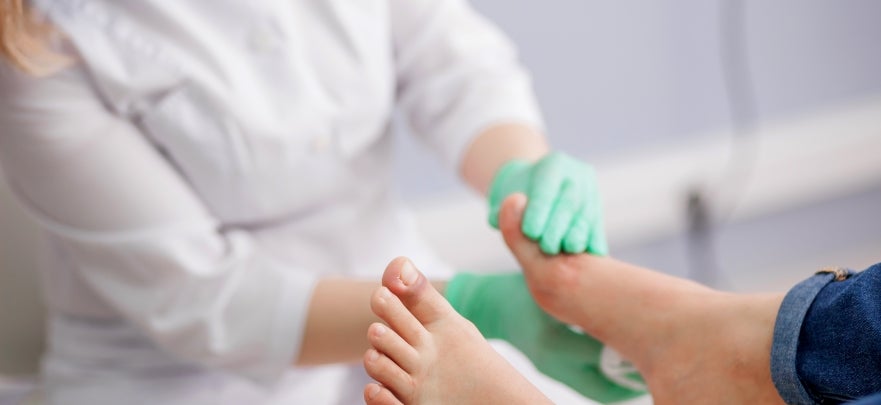Diabetic Foot Exam
People with diabetes are at higher risk for a variety of foot health problems. During a diabetic foot exam, your doctor will check for signs of infection, injury, bone abnormalities, nerve damage (neuropathy), and poor circulation (blood flow).
Neuropathy and poor circulation are the two most common foot conditions people with diabetes have.
Neuropathy can make your feet feel tingly or numb. In the case of a foot injury, complications can include calluses, blisters, and even deep sores, called ulcers, and you may not even know it. This could lead to worse infections.
Poor circulation due to diabetes may also make it harder for you to fight foot infections and heal from injuries. If you have diabetes and get a foot injury, your body may not recover fast enough. This could lead to infection, which could become serious very quickly. If you don't treat a foot infection immediately, it could become so severe that your foot may have to be amputated to save your life.
Regular diabetic foot exams can help prevent serious foot health problems. If you have diabetes, you should get a diabetic foot exam at least once a year. You may need an exam more often if you experience any tingling, numbness, pain, burning sensation, swelling in your foot, or difficulty walking. You don't need to do any preparations before a diabetic foot exam.
Call your healthcare provider right away if you have any of the following symptoms, which are signs of serious infection:
-
A blister, cut, or other foot injuries that don't start to heal after a few days
-
A foot injury that feels warm when you touch it
-
Redness around a foot injury
-
A callus with dried blood inside it
-
A sore that is black and smelly, indicating gangrene. If not treated promptly, gangrene can lead to amputation of the foot or even death.
During a diabetic foot exam, your doctor may ask questions about your health history and any previous problems you've had with your feet. Your doctor should also check your shoes for proper fit and ask questions about all of your footwear. Shoes that don't fit well can lead to blisters, calluses, and ulcers.
There are four specific types of assessments you should receive with your diabetic foot exam. These include:
-
Musculoskeletal assessment. Physical abnormalities in the shape and structure of your foot are checked.
-
Dermatological assessment.
-
The foot is checked for various skin problems, including dryness, cracking, calluses, blisters, and ulcers.
-
The toenails are checked for cracks or fungal infections.
-
Between the toes is checked for signs of a fungal infection.
-
Neurologic assessments. There are many different tests for neuropathy, including:
-
Tuning fork and visual perception tests (VPT): Placing a tuning fork or another device against your foot and toes to see if you can feel the vibration it produces.
-
Monofilament test: Brushing a soft nylon fiber called a monofilament over your foot and toes to test your foot's sensitivity.
-
Ankle reflexes: Tapping on your foot with a small mallet to check the reflex.
-
Pinprick test: Gently poking the bottom of your foot with a small pin to see if you can feel it.
-
Vascular assessment. Using a type of imaging technology called Doppler ultrasound to see how well blood is flowing in your foot.
If a problem is found, your doctor will likely recommend more frequent testing.
Foot problems can be a serious complication of diabetes. But you can help prevent and manage this by:
-
Checking your feet every day. Look for sores, ulcers, toenail cracks, and other changes in your feet.
-
Washing your feet every day.
-
Wearing shoes and socks at all times. Make sure your shoes are comfortable and fit well.
-
Trimming your toenails regularly.
-
Protecting your feet from excess heat and cold. Due to reduced sensation, you can burn your feet without knowing it. To protect your feet from hot or cold, never go barefoot. Wear socks in bed, and in the winter, wear lined, waterproof boots. Don't use heating pads or hot bottles on your feet. Before putting your feet in hot water, test the temperature with your hands.
-
Keeping blood flowing to your feet. Put your feet up when sitting. Wiggle your toes for a few minutes two or three times a day. Stay active, but choose activities that are easy on the feet, such as swimming or biking.
-
Getting regular diabetic foot exams. Get your feet checked at least once a year and more often if there is a problem.
-
Taking care of your diabetes. Work with a healthcare provider to keep your blood sugar at a healthy level and manage your diabetes.
Not Smoking. Smoking restricts blood flow to the feet and slows wound healing.






